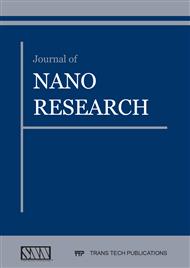[1]
Yu L, Luo H, Bian J G, et al. Research on Microstructure, Mechanical and Tribological Properties of Cr-Ti-B-N Films[J]. Coatings. 2017, 7(9), 137.
DOI: 10.3390/coatings7090137
Google Scholar
[2]
L.H. Yu, Y. Li, H.B. Ju, and J.H. Xu, Microstructure, mechanical and tribological properties of magnetron sputtered VCN films, surf. Eng. (2017).
DOI: 10.1080/02670844.2016.1277630
Google Scholar
[3]
Ju H, Yu D, Yu L, et al. The influence of Ag contents on the microstructure, mechanical and tribological properties of ZrN-Ag films[J]. Vacuum, 2017, 148.
DOI: 10.1016/j.vacuum.2017.10.029
Google Scholar
[4]
J.H. Xu, H.B. Ju, and L.H. Yu, Microstructure, oxidation resistance, mechanical and tribological properties of Mo-Al-N films by reactive magnetron sputtering, Vacuum, 103(2014), pp.21-27.
DOI: 10.1016/j.vacuum.2013.11.013
Google Scholar
[5]
I. MILOSEV, STREHBLOW H H, NAVINSEK B. Comparison of TiN, ZrN and CrN hard nitride coatings: Electrochemical and thermal oxidation[J]. Thin Solid Films, 1997, 303:246-254.
DOI: 10.1016/s0040-6090(97)00069-2
Google Scholar
[6]
Huang J H, Ho C H, Yu G P. Effect of nitrogen flow rate on the structure and mechanical properties of ZrN thin films on Si(100) and stainless steel substrates[J]. Material Chemistry and Physics, 2007, 102:31-38.
DOI: 10.1016/j.matchemphys.2006.10.007
Google Scholar
[7]
Pilloud D, Pierson J F, Cavaleiro A, Marco De Lucas M C. Effect of germanium addition on the properties of reactively sputtered ZrN films[J]. Thin Solid Films, 2005, 492:180-186.
DOI: 10.1016/j.tsf.2005.06.051
Google Scholar
[8]
Lopez G, Staia M H. High-temperature tribological characterization of zirconium nitride coatings[J]. Surface and Coatings Technology, 2005, 200:2092-(2099).
DOI: 10.1016/j.surfcoat.2004.08.221
Google Scholar
[9]
Deng J X, Liu J H, Zhao J L, Song W L, Niu M. Friction and wear behaviors of the PVD ZrN coated carbide in sliding wear tests and in machining processes[J]. Wear, 2008, 264:298-307.
DOI: 10.1016/j.wear.2007.03.014
Google Scholar
[10]
I. Milošev, H. H. Strehblow, B. Navinšek. Comparison of TiN, ZrN and CrN hard nitride coatings: Electrochemical and thermal oxidation[J]. Thin Solid Films, 1997, 303(1–2):246-254.
DOI: 10.1016/s0040-6090(97)00069-2
Google Scholar
[11]
H.B. Ju, L.H. Yu, D. Yu, I. Asempah, and J.H. Xu, Microstructure, mechanical and trobological properties of TiN-Ag films deposited by reactive magnetron sputtering, Vacuum, 141(2017), pp.82-88.
DOI: 10.1016/j.vacuum.2017.03.026
Google Scholar
[12]
H.B. Ju and J.H. Xu, Microstructure and tribological properties of NbN-Ag composite films by reactive magnetron sputtering, Appl. Surf. Sci., 355(2015), pp.878-883.
DOI: 10.1016/j.apsusc.2015.07.114
Google Scholar
[13]
C.P. Mulligan and D. Gall, CrN-Ag self-lubricating hard coatings, Surf. Coat. Technol., 200(2005), pp.1495-1500.
DOI: 10.1016/j.surfcoat.2005.08.063
Google Scholar
[14]
C.P. Mulligan, T.A. Blanchet, and D. Gall, CrN-Ag nanocomposite coatings: High-temperature tribological response, Wear, 269(2010), pp.125-131.
DOI: 10.1016/j.wear.2010.03.015
Google Scholar
[15]
C.P. Mulligan, T.A. Blanchet, and D. Gall, CrN-Ag nanocomposite coatings: Tribology at room temperature and during a temperature ramp, Surf. Coat. Technol., 204(2010), pp.1388-1394.
DOI: 10.1016/j.surfcoat.2009.09.018
Google Scholar
[16]
S.M. Aouadi, D.P. Singh, D.S. Stone, K. Polychronopoulou, F. Nahif, C. Rebholz, C. Muratore, and A.A. Voevodin, Adaptive VN/Ag nanocomposite coatings with lubricious behavior from 25 to 1000 °C, Acta Mater., 58(2010), No. 16, pp.5326-5331.
DOI: 10.1016/j.actamat.2010.06.006
Google Scholar
[17]
D.V. Shtansky, A.V. Bondarev, Ph.V. Kiryukhantsev-Korneev, T.C. Rojas, V. Godinho, and A. Fernández, Structure and tribological properties of MoCN-Ag coatings in the temperature range of 25-700°C, Appl. Surf. Sci.
DOI: 10.1016/j.apsusc.2013.02.055
Google Scholar
[18]
Ali Erdemir. A crystal chemical approach to the formulation of self-lubricating composite coatings[J]. Surface & Coatings Technology, 2005, 200:1792 -1796.
DOI: 10.1016/j.surfcoat.2005.08.054
Google Scholar
[19]
Z.W. Wu, F. Zhou, Q.W. Wang, Z.F. Zhou, and J.W. Yan, Influence of trimethylsilane flow on the microstructure, mechanical and tribological properties of CrSiCN coatings in water lubrication, Appl. Surf. Sci., 355(2015), pp.516-530.
DOI: 10.1016/j.apsusc.2015.07.146
Google Scholar
[20]
L. Braginsky, A. Gusarov, V. Shklover, Surf. Coat. Technol. 2009, 204: 629.
Google Scholar
[21]
J. Xu, H. Ju, L. Yu, Effects of Mo content on the microstructure and friction and wear properties of TiMoN films [J]. Acta Metallurgica Sinica. 2012, 48: 1132-1138.
DOI: 10.3724/sp.j.1037.2011.00751
Google Scholar
[22]
Ziegele H, Rebholz C, Voevodin A A, et al. Studies of the tribological and mechanical properties of laminated CrC–SiC coatings produced by rf and dc sputtering[J]. Tribol. Int. 1997, 30:845-856.
DOI: 10.1016/s0301-679x(97)00059-5
Google Scholar
[23]
K.E. Pappacena, D. Singh, O.O. Ajayi, J.L. Routbort, O.L. Erilymaz, N.G. Demas, and G. Chen, Residual stresses, interfacial adhesion and tribological properties of MoN/Cu composite coatings, Wear, 278(2012), pp.62-70.
DOI: 10.1016/j.wear.2012.01.007
Google Scholar
[24]
Ming L T, Chang C M, Cheng B H, et al. Multi-level surface enhanced Raman scattering using AgOx thin film[J]. Optics Express, 2013, 21(21):24460-7.
DOI: 10.1364/oe.21.024460
Google Scholar
[25]
Fujimaki M, Awazu K, Tominaga J, et al. Surface-enhanced Raman scattering from Ag nanoparticles formed by visible laser irradiation of thermally annealed AgOx thin films[J]. Journal of Applied Physics, 2006, 100(7):074303-074303-6.
DOI: 10.1063/1.2354329
Google Scholar
[26]
Souissi A, Amlouk M, Khemakhem H, et al. Deep analysis of Raman spectra of ZnO:Mo and ZnO:In sprayed thin films along with LO and TA+LO bands investigation[J]. Superlattices & Microstructures, 2016, 92:294-302.
DOI: 10.1016/j.spmi.2016.02.024
Google Scholar
[27]
Austin L A, Osseiran S, Evans C L. Raman technologies in cancer diagnostics[J]. Analyst, 2016, 141(2):476-503.
DOI: 10.1039/c5an01786f
Google Scholar
[28]
Gilder S. Raman spectroscopy of the titanomagnetites: calibration of the intensity of Raman peaks as a sensitive indicator of the Ti content[J].
DOI: 10.2138/am.2011.3745
Google Scholar
[29]
Muraoka K. Reaction steps of silicidation in ZrO2/SiO2/Si layered structure[J]. Applied Physics Letters, 2002, 80(24):4516-4518.
DOI: 10.1063/1.1486046
Google Scholar


